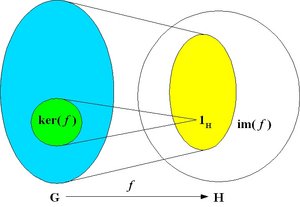Difference between revisions of "Group homomorphism"
From Online Dictionary of Crystallography
(→Types of homomorphisms) |
(symbol of the binary operation in H replaced by "#" to make it consistent with the entry "group isomorphism") |
||
| Line 2: | Line 2: | ||
==Groups== | ==Groups== | ||
| − | Let ''G'' and ''H'' be two non-empty sets with [[binary operation]]s * (in ''G'') and | + | Let ''G'' and ''H'' be two non-empty sets with [[binary operation]]s * (in ''G'') and # (in ''H''). If * and # are associative in ''G'' and ''H'' respectively and if ''G'' and ''H'' contain an identity element and the inverse of each element in them, then (''G'', *) and (''H'', #) are two groups. |
==Homomorphism between groups== | ==Homomorphism between groups== | ||
| − | A '''group homomorphism''' from (''G'', *) to (''H'', | + | A '''group homomorphism''' from (''G'', *) to (''H'', #) is a function ''h'' : ''G'' → ''H'' that preserves the composition law, ''i''.''e''. such that for all ''u'' and ''v'' in ''G'': |
<div align="center"> | <div align="center"> | ||
| − | ''h''(''u'' * ''v'') = ''h''(''u'') | + | ''h''(''u'' * ''v'') = ''h''(''u'') # ''h''(''v'') |
</div> | </div> | ||
where the group operation on the left hand side of the equation is that of ''G'' and on the right hand side that of ''H''. | where the group operation on the left hand side of the equation is that of ''G'' and on the right hand side that of ''H''. | ||
Revision as of 13:39, 19 March 2009
Homomorphisme de groupes (Fr). Gruppenhomomorphismus (Ge). Homomorfismo de grupos (Sp). Omomorfismo di gruppi (It). 準同形 (Ja).
Groups
Let G and H be two non-empty sets with binary operations * (in G) and # (in H). If * and # are associative in G and H respectively and if G and H contain an identity element and the inverse of each element in them, then (G, *) and (H, #) are two groups.
Homomorphism between groups
A group homomorphism from (G, *) to (H, #) is a function h : G → H that preserves the composition law, i.e. such that for all u and v in G:
h(u * v) = h(u) # h(v)
where the group operation on the left hand side of the equation is that of G and on the right hand side that of H.
The function h maps the identity element 1G of G to the identity element 1H of H, and it also maps inverses to inverses: h(u-1) = h(u)-1.
Image and kernel
The kernel of the homomorphism is the set of the elements of G that are mapped on the identity of H:
ker(h) = { u in G : h(u) = 1H }
The image of h is the subset of elements of H that are mapped by the homomorphism h:
im(h) = { h(u) : u in G }.
The kernel is a normal subgroup and the image is a subgroup of H.
Types of homomorphisms
- If the homomorphism h is a bijection, then its inverse is also a group homomorphism, and h is called an isomorphism; the groups G and H are called isomorphic and differ only in the notation of their elements, while they are identical for all practical purposes.
- An endomorphism is a homomorphism of a group onto itself: h: G → G.
- A bijective (invertible) endomorphism (which is hence an isomorphism) is called an automorphism. The set of all automorphisms of a group G forms itself a group, the automorphism group of G, Aut(G).
- An epimorphism is a surjective homomorphism, that is, a homomorphism which is onto as a function. The image of the homomorphism spans the whole set H: in this case, img(h) = H
- A monomorphism is an injective homomorphism, that is, a homomorphism which is one-to-one as a function. In this case, ker(h) = {1G }.
